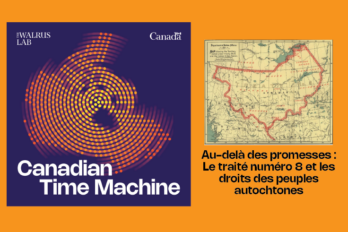SHOW NOTES:
SOURCES USED IN THIS EPISODE
The music for this episode is a licensed version of “This Podcast Theme” by InPlus Music. Additional music are licensed versions of “Stay Cool” by Loops Lab, “Podcast Intro” by InPlus Music, “Investigations” by Kevin MacLeod, and “Umbrella Pants” by Kevin MacLeod.
LINKS MENTIONED IN THIS EPISODE:
ADDITIONAL LINKS:
TRANSCRIPT:
SHEENA ROSSITER: Welcome to the Deep Dive, a weekly podcast that takes a deeper look into the happenings at The Walrus. I’m Sheena Rossiter.
ANGELA MISRI: And I’m Angela Misri. On this week’s episode:
NICOLE SCHMIDT: when all of this started, I noticed a lot of talk online about which fashion items were sort of expected to disappear as a result of the pandemic, and among those was the bra. And when I started looking into it though, I realized that the bra wasn’t going anywhere, just like how we wear it was changing.
ANGELA MISRI: This week we’re talking all about bras. Love them or hate them, people have opinions. During this pandemic, there’s been a shifting trend that shows old forms of bras are going bust. So is this just a fashion blip or a sign of something bustier? Sorry, I couldn’t help myself.
SHEENA ROSSITER: Well, Angela, when we posted Nicole Schmidt’s story, “Underwire Under Fire: How the Pandemic Changed the Bra” on our website, our Twitter feed just lit up. Quite frankly, quite a few people, no matter what their cup size was, well, they’ve ditched their typical underwire bras for something more comfortable, or they aren’t even wearing bras at all anymore.
ANGELA MISRI: This week we’ll hear from Nicole Schmidt, the writer behind the story. She’s an associate editor here at The Walrus. And then later, illustrator Kate Traynor will talk about the illustration she created for the story.
SHEENA ROSSITER: This is part of our latest digital series at The Walrus, hope your well, which delves into everything about wellness.
ANGELA MISRI: Now let’s check out your conversation with Nicole Schmidt.
SHEENA ROSSITER: So Nicole, bras, what sort of discomfort piqued your interest to write a 1600-word or long form article about this?
NICOLE SCHMIDT: Yeah, I guess I hadn’t thought as much about bras until I really got into this article. But I myself used to have a drawer filled with push-up bras in like every colour you can imagine. And I’ve spent a lot of time thinking about why that was the case. And I mean, maybe this is too much info for a podcast, but I have a smaller chest. So I honestly think that I was wearing this style of bra, because I thought or wanted to look a certain way in clothing. I just reached a point where I got really tired of that.
And I mean, I feel like you’d be hard pressed to find a woman who will tell you that a bra is comfortable, that they really enjoy wearing one. I got rid of all of those and these days I either just don’t wear bra or I wear a bralette. And I mean the pandemic, I think got us all thinking about fashion and the types of clothes that we wear. And when all of this started, I noticed a lot of talk online about which fashion items were sort of expected to disappear as a result of the pandemic and among those was the bra. And when I started looking into it though, I realized that the bra wasn’t going anywhere, just like how we wear it was changing.
SHEENA ROSSITER: I mean, this is really funny because I did see a meme online and it was of a Renaissance painting or during that period of time. And it’s a topless woman who’s just kind of chilling out and the meme jokingly reads, “Now that I’ve lived during a plague, I understand why most Renaissance paintings are of chubby women laying around without a bra”. Have you seen it by chance?
NICOLE SCHMIDT: I have not, but obviously I’m going to go look it up immediately after this conversation.
SHEENA ROSSITER: How have women’s undergarments sort of transformed and evolved over time, especially when we go through transformative periods in history like a pandemic?
NICOLE SCHMIDT: I mean, the history of the bra is long and complex and very interesting, but I guess I will try to give you the sort of spark notes version if you will. The earliest iteration of the bra actually goes all the way back to ancient Greece. There are these old wall paintings that historians discovered that show female athletes wearing what essentially looks like a bandeau. It’s like a piece of cloth strapped around and safety pinned in the back. And what we fast forward into the middle ages that is of course, when you have the corset craze, which was really designed to help women achieve this hourglass figure.
And the corset stuck around for many years, about 400 years to be exact and effect that I really love is that during the first world war in an attempt to save metal for the war effort, women were actually asked to stop buying them. And one step that I came across actually says that women stopping wearing corsets actually saved approximately 28,000 pounds of steel, which is enough to build two battleships. It’s wild. But the other thing that was sort of happening in tandem with that is that during the war, a lot more women were going into the workforce. They’re starting to work in factories. (singing)
And I personally have never tried to do manual labour in a corset, but I can imagine that it is not an easy task. So obviously, women needed something that was easier for them to move around in, that suited their needs a little bit better. And that’s when we saw this pivot towards what we think of as the modern bra. And there have been some really funny iterations of it through the years. I mean, you had the bullet bra in the 40s and 50s, which had this cone shape.
If you look at old photos of Marilyn Monroe and the pinup women of the era, when I was researching for this story, I have a book of bra history and I came across an ad from the 50s for an inflatable bra, which actually came with a straw to help you blow it up like the life jacket that you get under your seat on an aeroplane. And then in the 70s, that’s when you had the launch of the WonderBra. (Singing) This push-up era that stuck around and led to these Victoria’s Secret styles that I guess we’ve seen over the past two decades. And the moment that we’re in now is sort of the bralette sports bra style that pivots away from push-ups. So yes, that is my very brief history of the bra.
SHEENA ROSSITER: Obviously a lot of things have changed during the pandemic and this is certainly one of them. And we have seen a huge emergence of new companies, especially for women offering more bras and stuff like that. So what have you heard from other people about their bras or their braless experience during the pandemic?
NICOLE SCHMIDT: One of my favourite internet trends that happened during the pandemic was last January. There was this TikTok challenge going around with people cutting apart their old patted bras and turning them into these really cute, lazy bralettes. And I feel that in a lot of ways is really symbolic for the moment that we’re in and this sort of trend vision that we’re going through. But I think the biggest thing, again, like I ditched the bra pre pandemic, but for a lot of women who were spending more time at home, I really think it was an opportunity to maybe try something that they might not have felt comfortable wearing before.
Because the thing with the bralette of course, is that it really embraces your natural shape and there are pressures to look a certain way or present a certain way when you’re in a workplace. Especially, I really do think that in a lot of ways, the pandemic sort of amplified this trend that we had already been seeing before we were all stuck at home. But yeah, it was just sort of the final push that a lot of people maybe needed to give it a try.
SHEENA ROSSITER: So similar to the cosmetics industry, clothing companies are starting to explode online through targeted marketing and through social media influencers. What are some of the companies that have really popped up during this time and during this moment, namely during the pandemic that have relied more on the social media marketing and also this shift in attitudes where companies like Victoria’s Secret may not be as popular?
NICOLE SCHMIDT: The thing that I find interesting about Victoria’s Secret specifically is, they retired their angels last year. Of course, these very slim tone women with big boobs. They deemed them not culturally relevant, which I find very interesting, but in terms of companies, I think the big one among Canadians is Knix. They have gotten really popular over the past couple of years and I saw a stat actually that said they saw a 100% increase in sales between January 2021 and the year before, which is just wild.
And they specialize completely in wire free, comfortable underwear. But I think there has been this trend happening in tandem with a lot of independent, smaller retailers as well. For the story I spoke with Fortnight, they’re a Toronto based lingerie company and also Stay Soft in Montreal. And both said that they saw increased interest at the start of the pandemic, especially. And I mean, well, we’re on the topic of the pandemic, I feel like a lot of us have sort of realize the importance of helping smaller brands in our own communities.
SHEENA ROSSITER: There are certain occasions that do call for that wire. There are certain situations where you do need that little extra support, especially for women who are more top heavy. If there is a night out on the town, would they still want that magical push-up bra?
NICOLE SCHMIDT: I think what’s particularly interesting about the moment that we’re in now is that there’s no dominant shape or silhouette. If you look at how the bra has evolved, historically, the shape of the bra has always been to help people achieve a certain look or certain shape. But now since we’re embracing more of ourselves and there’s such a growing tolerance and acceptance of different body types, I honestly think the best part about this moment is that it doesn’t matter what you wear as long as you feel good at it. So yeah, it’s about options. Just like the fact that you don’t have to wear underwire on a push-up if you don’t want to. But if that is the thing that you put on and it makes you feel good and confident, then that is also great.
SHEENA ROSSITER: And now here’s my conversation with Kate Traynor about the illustration for this article.
SHEENA ROSSITER: Nicole really went in to explain the evolution of the bra and how it’s changed over the years and why. When you read through Nicole’s piece, while you were doing the initial mockups for the illustration, what struck you in terms of inspiration?
KATE TRAYNOR: After reading Nicole’s article, my initial thoughts were all the ways in which bras have cost so much pain over the years from corsets to modern day more push-up wire bras. So I was really interested in figuring out a way to visualize certain issues that we had with bras throughout the years, the dips into the shoulders, the underwire poking through, the way it misshapes and basically fights against women’s natural body.
SHEENA ROSSITER: Being a woman yourself. Could you kind of relate to the evolution of the bra and also the transformation that we’ve been experiencing during the pandemic?
KATE TRAYNOR: Oh, absolutely. I mean, I’ve been wearing bralettes and wire free bras for probably all of my adult life. So I think I maybe did the transition a little bit sooner because I don’t think I’ve ever worn a wired bra when going into a corporate job, for example. And now working from home, I can’t imagine wearing anything else.
SHEENA ROSSITER: So you were really on trend well before the pandemic here?
KATE TRAYNOR: Yeah, exactly.
SHEENA ROSSITER: Now I’ve seen the mockups for the illustrations and well, since this is a podcast, of course. Can you just describe what the original idea looked like?
KATE TRAYNOR: So I came up with about three or so concepts that I initially sketched up for this article. The first illustration, which is the one that we turned into the final illustration is a row of women going from left to right, basically showing the evolution of bras throughout the generation. So we start at a corset and then we move into the bullet bra, which was really popular in the 1950s. And then we move into maybe early 2000s the Victoria’s secret push-up bra, all the way to today’s more modern day, commonly known like Knix brand bras, which they’re more seamless and they are just a little bit more supportive for most women.
And then the second concept was a little bit more fun and playful, is organic looking. It’s basically a woman in the middle and it looks as though she’s unzipping away the generations of bras past and peeling away to our now modern date woman. And then the last concept is a little bit more simplified. It’s more of a one-on-one comparison of a woman wearing a wired bra and trying to basically undo the back of the bra. And then the other woman is just relaxed, comfortable, wearing her bralette, not having to worry about the discomforts of the straps.
SHEENA ROSSITER: Do you think the bralettes and the pandemic fashion with undergarments for women is here to stay?
KATE TRAYNOR: I don’t know. That’s a tough one to say for sure. I mean, I feel like most people have embraced it. I know there’s some challenges with people feeling like they maybe aren’t fully covered in certain areas. Although most of us, if you’re in a pandemic and you work remote, a lot of times you don’t have to worry about that.
SHEENA ROSSITER: And now let’s check out what Nicole Schmidt is listening to right now.
NICOLE SCHMIDT: So I have been very obsessed with this podcast called Spectacle: Las Vegas. Anyone who knows me knows that I love reality television and this 10 episode podcast takes a look at different reality TV shows over the years and how they’ve evolved historically from Survivor, to The Bachelorette, to Queer Eye, to 90 Day Fiancé and it is absolutely delightful.
SHEENA ROSSITER: And here’s what Kate Traynor is reading right now.
KATE TRAYNOR: Right now for my monthly book club. I’m reading “Atomic Habits” by James Clear. Basically, it’s about creating new habits for a healthy everyday life and forming just a structure to live life more comfortably, more peacefully and with purpose.
SHEENA ROSSITER: That’s my conversation with Nicole Schmidt, an associate editor at The Walrus. And then you heard me speaking with illustrator, Kate Traynor. The editor for Nicole’s story was Carine Abouseif. Our direction for Kate’s illustration was done by Celina Gallardo. You can read Nicole’s story Underwire Under Fire: How the Pandemic Changed the Bra at
WHAT WE’RE TALKING ABOUT THIS WEEK AT THE WALRUS:
MIHIRA LAKSHMAN: I’m Mihira Lakshman and here’s what we’ve been talking about this week at The Walrus. We’ve been closely watching the evolving situation in Ukraine as Russian forces continue their occupation of the country. Canada has the largest Ukrainian diaspora outside of Russia, and there have been numerous protests across our country against the conflict and in solidarity with Ukraine. That got us revisiting the photo essay by Christopher Bobyn, “How to Train a Ukrainian Soldier”, which visually captures Canadian troops training Ukrainian troops on modern military tactics.
One high profile Ukrainian Canadian, deputy prime minister Chrystia Freeland has spoken out about Russian president Vladimir Putin’s actions. Our website was full of searches for content on Russia and Ukraine and our deputy prime minister unearthing stories about Freeland, including “Embedded with the 0.01%” by John Lawrence and Simon Lewsen’s profile piece “Chrystia Freeland Wants to Fix the Twenty-First Century”. And last week’s viral story by Jennifer Robertson continues to blow up all our channels, website, podcast and social media. If you haven’t heard her talk with Sheena Rossiter, scroll back through past episodes of this podcast and hear her story. Her episode is called “Confessions of a Bitcoin Widow”, and it’s not to be missed. As always the links for all these articles can be found in the show notes for this episode.
CREDITS:
SHEENA ROSSITER: Thanks for joining us on this week’s episode of the Deep Dive. It was produced by Angela Misri, and me, Sheena Rossiter. I also edited this episode.
Thanks so much to Nicole Schmidt and Kate Traynor for joining us this week.
Music for this podcast is provided by Audio Jungle. Our theme song is This Podcast Theme by Inplus Music. Additional music is Stay Cool by Loops Lab, and Podcast Intro by Inplus Music. You also heard “Investigations” and “Umbrella Pants” by Kevin MacLeod, provided by Film Music.
Investigations by Kevin MacLeod
Link: https://incompetech.filmmusic.io/song/3924-investigations
License: https://filmmusic.io/standard-license
Umbrella Pants by Kevin MacLeod
Link: https://incompetech.filmmusic.io/song/4559-umbrella-pants
License: https://filmmusic.io/standard-license
Additional sources for this episode were provided by Mars on Furs, Michael Levy, and “Rosie the Riveter” by the Four Vagabonds from Glamour Daze on YouTube.
Don’t forget to subscribe to Deep Dive from The Walrus on Apple Podcasts, Spotify, or wherever you get your podcasts. And if you like what you heard, please leave us a review and rating. It really helps people find the podcast.
Until next week when we take our next deep dive.








